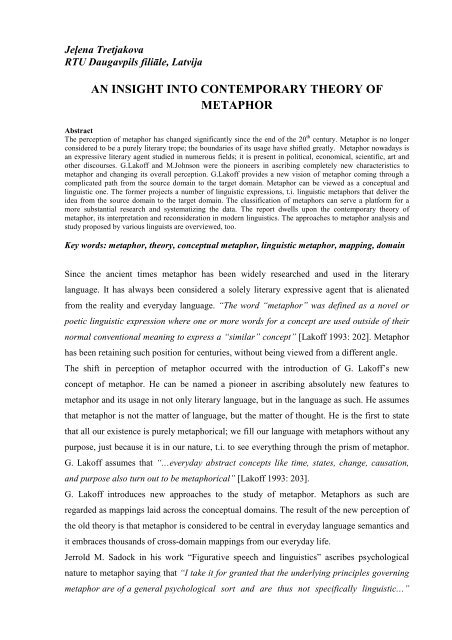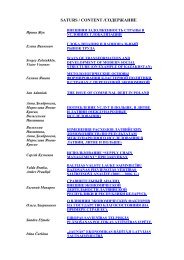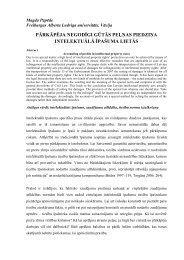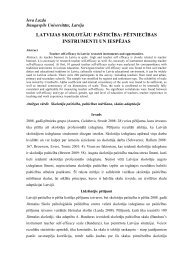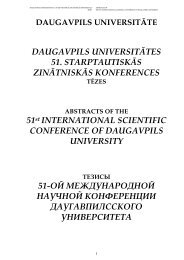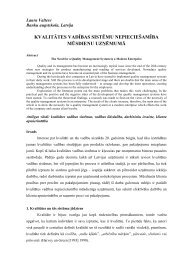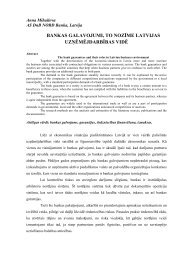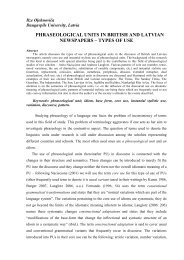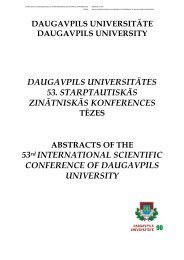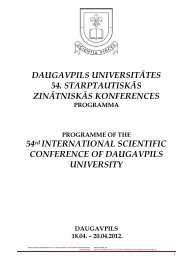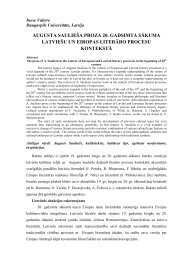AN INSIGHT INTO CONTEMPORARY THEORY OF METAPHOR
AN INSIGHT INTO CONTEMPORARY THEORY OF METAPHOR
AN INSIGHT INTO CONTEMPORARY THEORY OF METAPHOR
- No tags were found...
Create successful ePaper yourself
Turn your PDF publications into a flip-book with our unique Google optimized e-Paper software.
Jeļena TretjakovaRTU Daugavpils filiāle, Latvija<strong>AN</strong> <strong>INSIGHT</strong> <strong>INTO</strong> <strong>CONTEMPORARY</strong> <strong>THEORY</strong> <strong>OF</strong><strong>METAPHOR</strong>AbstractThe perception of metaphor has changed significantly since the end of the 20 th century. Metaphor is no longerconsidered to be a purely literary trope; the boundaries of its usage have shifted greatly. Metaphor nowadays isan expressive literary agent studied in numerous fields; it is present in political, economical, scientific, art andother discourses. G.Lakoff and M.Johnson were the pioneers in ascribing completely new characteristics tometaphor and changing its overall perception. G.Lakoff provides a new vision of metaphor coming through acomplicated path from the source domain to the target domain. Metaphor can be viewed as a conceptual andlinguistic one. The former projects a number of linguistic expressions, t.i. linguistic metaphors that deliver theidea from the source domain to the target domain. The classification of metaphors can serve a platform for amore substantial research and systematizing the data. The report dwells upon the contemporary theory ofmetaphor, its interpretation and reconsideration in modern linguistics. The approaches to metaphor analysis andstudy proposed by various linguists are overviewed, too.Key words: metaphor, theory, conceptual metaphor, linguistic metaphor, mapping, domainSince the ancient times metaphor has been widely researched and used in the literarylanguage. It has always been considered a solely literary expressive agent that is alienatedfrom the reality and everyday language. “The word “metaphor” was defined as a novel orpoetic linguistic expression where one or more words for a concept are used outside of theirnormal conventional meaning to express a “similar” concept” [Lakoff 1993: 202]. Metaphorhas been retaining such position for centuries, without being viewed from a different angle.The shift in perception of metaphor occurred with the introduction of G. Lakoff’s newconcept of metaphor. He can be named a pioneer in ascribing absolutely new features tometaphor and its usage in not only literary language, but in the language as such. He assumesthat metaphor is not the matter of language, but the matter of thought. He is the first to statethat all our existence is purely metaphorical; we fill our language with metaphors without anypurpose, just because it is in our nature, t.i. to see everything through the prism of metaphor.G. Lakoff assumes that “…everyday abstract concepts like time, states, change, causation,and purpose also turn out to be metaphorical” [Lakoff 1993: 203].G. Lakoff introduces new approaches to the study of metaphor. Metaphors as such areregarded as mappings laid across the conceptual domains. The result of the new perception ofthe old theory is that metaphor is considered to be central in everyday language semantics andit embraces thousands of cross-domain mappings from our everyday life.Jerrold M. Sadock in his work “Figurative speech and linguistics” ascribes psychologicalnature to metaphor saying that “I take it for granted that the underlying principles governingmetaphor are of a general psychological sort and are thus not specifically linguistic…”
[Sadock 1993: 42]. Metaphors arise independently on the language system, thus they are notdirectly referred to it. The idea expressed is similar to that developed by G. Lakoff, and isshifting the role of metaphor. We are prone to base our knowledge on experience, and theempirical foundation as such lays the basis for metaphoricity.Based on the two postulates expounded above, it could be said that our everyday language isto a great extent metaphorical. Mappings are formed in the mind and laid from the sourcedomain to the target domain. The concept of metaphor has resounded differently, namely, as“a cross-domain mapping in the conceptual system. The term “metaphorical expression”refers to a linguistic expression (a word, phrase, sentence) that is the surface realization ofsuch a cross-domain mapping” [Lakoff 1993: 203]. The mappings are considered to be theset of correspondences and have a definite structure. G. Lakoff introduces mnemonicdesignation of the mappings giving them the following form: TARGET-DOMAIN ISSOURCE-DOMAIN or TARGET-DOMAIN AS SOURCE-DOMAIN. The concept isexplicitly shown on the example of the mapping LOVE IS A JOURNEY. He assumes that theset of metaphoric correspondences that arise through the aforementioned mapping could be asfollows:• Those involved in the love affair correspond to travelers;• The relationships between lovers correspond to a vehicle• The common goal of the lovers corresponds to the common destination on the journey.Thus, the metaphorical expressions occurring in reference to this could be as follows: The relationship isn’t going anywhere. Our relationship is off the track. We can’t turn back now. We may have to go our separate ways. Our relationship has hit a dead-end street. [Lakoff 1993: 206]G. Lakoff emphasizes that it is a common error to confuse the name of the mapping with themapping itself. LOVE IS A JOURNEY is a name of the mapping causing the set ofcorrespondences. Names of the mappings are offered just for developing the further set ofmetaphorical correspondences. Thus, G. Lakoff identifies mappings to conceptual metaphors,or, in other words, set of conceptual or as he proposes, ontological, correspondences. Theycould be considered the path across the source domain to the target domain.As a point of significance, G. Lakoff also differentiates between conceptual metaphors andlinguistic expressions. In all the examples referring to the mapping LOVE IS A JOURNEY
we do not observe a number of metaphors, it is just one conceptual metaphor with a row oflinguistic expressions – a metaphor of love being conceptualized as a journey, and beingexpressed by a variety of metaphorical expressions. Thus, metaphors could be referred to asconceptual mappings, or metaphors, with the metaphorical expressions being individuallinguistic expressions. [Lakoff 1993: 209]. This path from the source domain to the targetdomain thus could be schematically shown as follows:SOURCE DOMAINTARGET DOMAINMAPPINGS(CONCEPTUAL <strong>METAPHOR</strong>S)<strong>METAPHOR</strong>ICAL EXPRESSIONS(LINGUISTIC <strong>METAPHOR</strong>S)The source domain lays the foundation for the concept, which in its turn forms mappings, orconceptual metaphors. The conceptual metaphor will further provide a whole number oflinguistic expressions, or as we might call them linguistic metaphors, that finally deliver theidea to the target domain.Zoltàn Kövecses develops Lakoff’s idea of differentiation between metaphors as mappingsand metaphors as metaphorical expressions, pointing out that metaphorical expressions aresolely the representation of the mappings [Kövecses 2010: 45]. Representation of themappings, or in other words, conceptual metaphors, projected from the source domain canpass a long way towards the target domain until they transfer the notion to the recipient. Sincethese paths may vary to a great extent, he suggests there should be differentiation betweenkinds of conceptual metaphors. There might be various aspects that allow us to categorizemetaphors. This report dwells upon on categorization of conceptual metaphors in accordanceto their conventionality and function. Let us have a brief insight into implication of each ofthe aforementioned categories.1. The conventionality of metaphorThis could be named a most comprehensible aspect representing the essence of metaphor. Thequestions that arise under the theme is how deeply rooted the metaphor is; how widely-usedand accepted it is by the ordinary public. Thus, to define the degree of the metaphor’sconventionality, one should trace the usage of the metaphor in speech; to see how wellestablished it is in our minds. Here Kövecses proposes a term of “conceptualized”, or highlyconventionalized, metaphor, t.i. a metaphor that is well established and deeply entrenched[Kövecses 2010: 34]. This approach supports the idea of the world being deeply metaphorical,
since in our ordinary communication use of metaphor can remain unnoticed; we may use itwithout deliberate purpose. If one says: “He has defended his point of view persuasively”, or“We have to construct a new strategy”, or “The business is growing fast”, the speaker willcognize the idea immediately. This allows us to assume that such conceptual metaphors, ormappings, respectively as UPHOLDING OPINIONS IS WAR, STRATEGY IS ABUILDING or ORG<strong>AN</strong>IZATIONS ARE PL<strong>AN</strong>TS are highly conventional. They can becomprehended easily by the majority of recipients.Such highly conventional metaphors are considered in opposition to the unconventional ornovel metaphors. The mappings can still be conventional but the metaphorical expressionsused to deliver the idea to the target domain can be unconventional in their nature. Themetaphors of such type can be found not only in poetic language; a lot of contemporarycommercial artists, politicians, journalists and representatives of other professions are inconstant search for such non-standard linguistic expressions to manifest their ideas. Theexamples of this kind of metaphors could be as follows:• Stop the world. I want to get off. – The mapping of the metaphor is LIFE IS AJOURNEY, which is a purely conventional conceptual metaphor. But themetaphorical expressions chosen for manifesting the idea are out of the ordinary andseem unconventional.• “If a man empties his purse into his head, no man can take it away from him. Aninvestment in knowledge always pays the best interest” (a quote by BenjaminFranklin). – We could assume that the conceptual metaphor KNOWLEDGE ISWEALTH is quite a conventionalized one, but the linguistic expressions used by theauthor are uncommon.The conventionality of the source domain mappings makes it easy to perceive the ideaexpressed by the author. The situation will differ if both the conceptual metaphor and itsrepresentation in the target domain are unconventionalized. Let us consider an advertisingslogan of the Kleenex Company for the Kleenex Tissues, which sounds like: “Don’t put acold in your pocket!” We could map the following conceptual metaphor: DESESASES AREPHYSICAL OBJECTS which can hardly be regarded as a conventional one. The linguisticexpressions used to signify the idea are not common, either. Thus the perception of the idea isnot easy. The usage of such conceptual metaphors could be to a great extent conditioned bythe willingness of the author to attract the recipient, to make the speech or writing moreimpressive and to make the target audience think.2. The function of the metaphor
The function of metaphor could be another prerequisite for relating metaphor to a certaincategory. Z. Kövecses suggests there should be three kinds of metaphors distinguished inaccordance to their cognitive function, namely, structural, ontological and orientational ones.Let us have a brief review of the metaphors named above.2.1. Structural metaphorsStructural metaphors arise when the source domain provides "rich knowledge structure for thetarget concept” [Kövecses 2010: 37]. The source target projects easily perceived andcomprehensible mappings that deliver the metaphor to the target source in a comprehensibleway. Z. Kövecses explicates the idea using the concept of time. If we consider the followingexamples,• The time for action has arrived;• I’m looking ahead to Christmas;• Time is flying by;• Thanksgiving is coming up on us [Kövecses 2010: 38]we could see that the conceptual metaphor can be represented as a mapping TIME PASSINGIS MOTION <strong>OF</strong> <strong>AN</strong> OBJECT. The observer has a steady position and the things, objects aremoving towards him.In contrast, the following mapping can arise – TIME PASSING IS <strong>AN</strong> OBSERVER’SMOTION OVER A L<strong>AN</strong>DSCAPE with the following examples:• His stay in Russia extended for many years;• We passed the time happily;• We are getting close to Christmas.In the aforementioned metaphorical expressions the time gains steady fixed position and theobserver is moving towards it. The understanding of both source domain and target domainmake the metaphor clear and more comprehensible. One concept is metaphorically structuredin terms of another. [Lakoff, Johnson 1980: 14]2.2. Ontological metaphorsCollins Concise English Dictionary provides the following definition of ontology: “the branchof metaphysics that deals with the nature of being.” [Collins Concise English Dictionary2008: 1166] Ontological metaphors are less transparently projected from the source domain tothe target concept. Their task is to provide new ontological status to general categories ofabstract target concepts. The abstract notions can be referred to as entities. This can beachieved through the introduction of ontological metaphors that might serve the purpose ofquantifying, identifying, referring, setting goals etc. In other words, they contribute to thecomprehension of nonphysical objects as an entity. An abstraction, such as an activity,
emotion, or idea, is represented as something concrete, such as an object, substance,container, or person. G. Lakoff and M. Johnson provide the following examples to manifestthe use of ontological metaphors:• I can’t keep up with the pace of modern life. [Lakoff, Johnson 1980: 27] –Life courseis perceived as speed of some physical object. His emotional health has deterioratedrecently. The pressure of his responsibilities caused his breakdown. [Lakoff, Johnson1980: 27] – Health, emotional state of a person or work appear to adopt some physicalabilities not usual to the abstract notions.• He went to New York to seek fame and fortune. I want to find true happiness in thislife. [Lakoff, Johnson 1980: 27] – Fame and happiness are apprehended as physicalobjects that could be lost, found, moved etc.Personification can be assumed of as a form of ontological metaphor. A physical object ismapped to the target domain as a human being. Such mappings allow us to perceive nonhumanentities through human characteristics, motivations, actions, etc. Consider theexamples below:• Inflation is eating up our profits. This fact argues against the standard theories. Lifehas cheated me. [Lakoff, Johnson 1980: 33]The examples above have one feature in common, i.e. they characterize the nonhuman interms of human behavior. G. Lakoff goes further into the detailed study of personifiedontological metaphors, mentioning that the nature of personification may differ. Inconsidering the examples below we can draw some other conclusions related to the essence ofpersonification.• Our biggest enemy right now is inflation. Inflation has robbed me of my savings. Thedollar has been destroyed by inflation. [Lakoff, Johnson 1980: 33].The conceptual metaphor built into the source domain is not just INFLATION IS A PERSON(as in the previous set of examples), but rather INFLATION IS <strong>AN</strong> ENEMY. Such mappingcontributes to the better understanding of not just the behavior of inflation but of the potentialactions against it. Personification provides for the use of one of the most accessible and closeto the human being source domains, namely, our own existence.2.3. Orientational metaphorsOrientational metaphors can be opposed to the structural ones in such a way that they do notbuild the metaphorical structure of one concept in terms of another, but rather “…organize awhole system of concepts with respect to one another” [Lakoff, Johnson 1980: 14]. They aregiven the term of “orientational” due to their spatial focus: in-out, up-down, from-to, etc. Thenature of orientational metaphors lays deeply in our physical structure or culture. Thus, it is
common to relate most positive feelings to movement up, and negative ones – to movingdown. This could be due to the physical specifics of our body to be straight up in reference topositive state, and drooping posture manifesting sadness or unhappiness. The examples beloware illustrating the theory:• I’m feeling up. My spirits rose. He’s in high spirits. – I’m feeling down. He’s reallylow these days. My spirits sank. [Lakoff, Johnson 1980: 15]Another conceptual metaphor designating the use of orientational metaphor could beHEALTH <strong>AN</strong>D LIFE ARE UP and SICKNESS <strong>AN</strong>D DEATH ARE DOWN. The commonexamples, such as “He is in top shape”, “He is at the peak of health”, and “He came downwith the flu”, “His health is declining” [Lakoff, Johnson 1980: 15] are explained by thephysical basis common to everyone, i.e. during an illness we tend to take lying position, whilegetting better suggests getting up and taking upward position. [Lakoff, Johnson 1980: 16].This category of metaphors is widely represented in the language.Contemporary theory has broadened the borders of metaphor study. It has viewed metaphorfrom a different angle. Metaphors may be classified variously and in many cases there mightbe overlaps between the categories. Thus, orientational metaphors could have functions ofontological ones, while some ontological metaphors could be purely structural in their nature.However, any differentiation and subsumption might help a linguist to structure his analysisor systematizing the data. This study presents just a superficial insight into some categories ofmetaphor and contemporary theory of metaphor. The classification reviewed above couldserve a platform for a more essential study both of theoretical and practical material. Usingthe classification of metaphors allows us to cognize the conceptuality of the world and to tracethe metaphoricity more efficiently.Bibliography1. Knowles M., Moon, R. Introducing Metaphor. Taylor & Francis e-Library, 2005.2. Kövecses, Z. Metaphor. A Practical Introduction. Oxford University press, Inc., 20103. Lakoff, G. Johnson, M. Metaphors, We Live by. Chicago: University of ChicagoPress, 1980.4. Lakoff, G. The Contemporary Theory of Metaphor In: Ortony, A. Metaphor andThought. Second Edition: Cambridge University Press, 1993 (pp. 202 – 252)5. Sadock, J.M. Figurative Speech and Linguistics. In: Ortony, A. Metaphor andThought. Second Edition: Cambridge University Press, 1993 (pp. 42 – 58)6. Collins Concise English Dictionary. HarperCollins Publishers, 2008.


